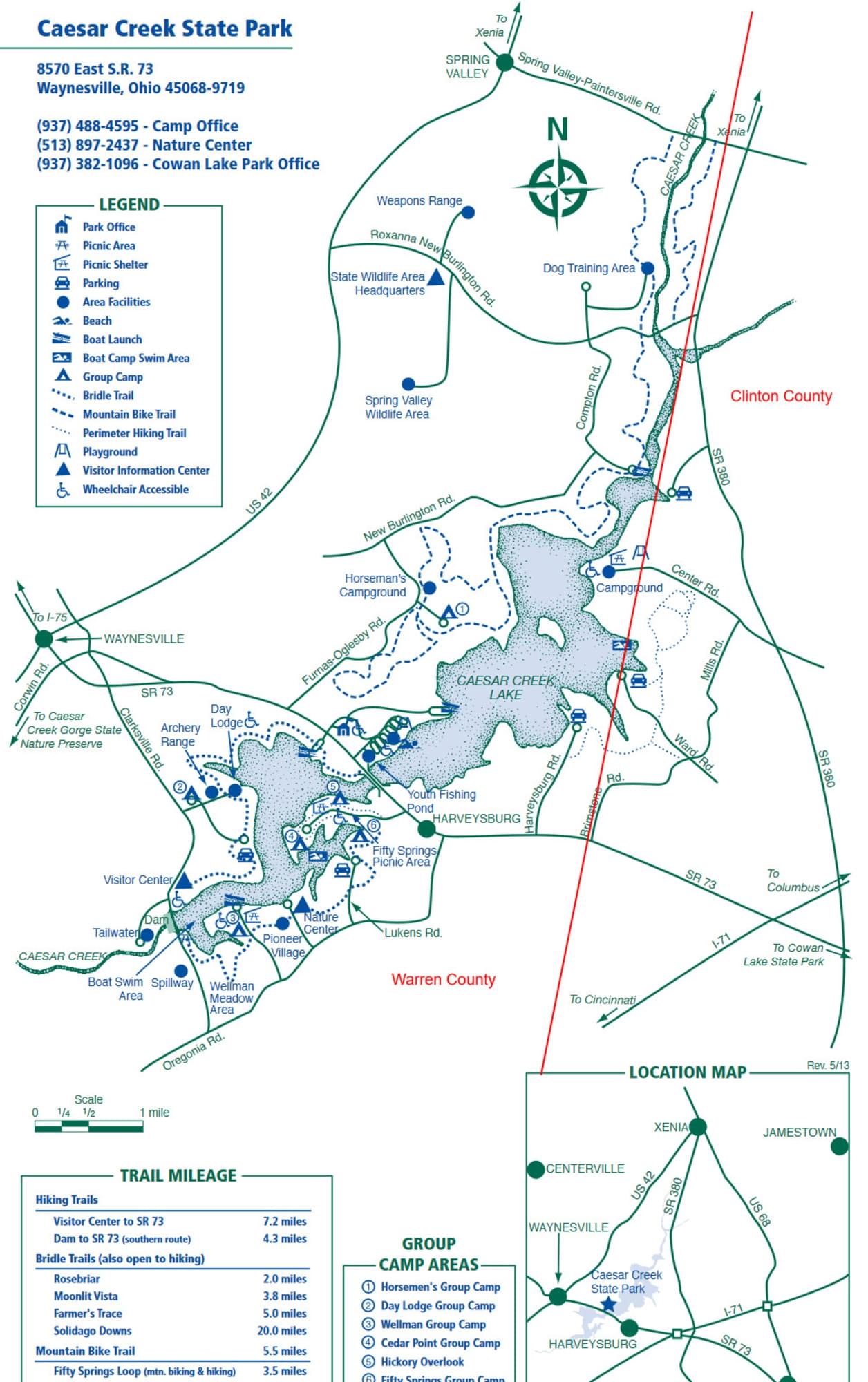Caesar Creek SP (Warren Co.)
Caesar Creek SP (Warren Co.)
Waynesville, Ohio 45068
Caesar Creek State Park websiteCaesar Creek State Park map
Caesar Creek Lake map
Also, see all the hotspots at:
Caesar Creek Important Bird Area
Tips for Birding
The park consists of 3,741 land acres and 2,830 water acres; another 2,959 wildlife acres are nearby. These areas feature woodlands, meadows, a prairie grass area, and two swimming beaches. There are 43 miles of hiking trails and 2 mountain bike trails.
The public beach can be good for gulls and shorebirds, especially early in the morning. Merganser Bay at the end of Harveysburg Road is especially good for waterfowl. There are many other good birding areas, including the campground, Luken’s Road, and Caesar Creek Gorge. During winter months the feeders at the Visitors Center can be good for Purple Finches and Pine Siskins. Rare species observed in the park include Laughing Gull, Lesser Black-backed Gull, California Gull, Red-throated Loon, Pacific Loon, Red-necked and Western Grebes, American Avocet, Marbled Godwit, Willet, Baird’s Sandpiper, Piping Plover, Sanderling, Surf Scoter, White-winged Scoter, Long-tailed Duck, and American White Pelican.
From Waynesville, go east on OH-73 to Clarksville Road, turn right to Visitor’s Center, or continue on OH-73 to main park entrance on left.
The park is open daylight hours only.
There is plenty of parking throughout the park.
There is a list of birds seen recently at the Visitors Center where a checklist of the Birds of Caesar Creek is also available.
From Waynesville, go east on OH-73 to Clarksville Road, turn right to Visitor’s Center, or continue on OH-73 to main park entrance on left.
Birds of Interest
Winter
American Black Duck, Lesser Scaup, Redhead, Common Loon, Bald Eagle, Northern Harrier, Northern Mockingbird, Red-shouldered Hawk, Fox Sparrow, Ring-billed Gulls
Spring
Pied-billed Grebe, Horned Grebe, Spotted Sandpiper, spring waterfowl and songbird migrants.
Summer
Lesser Yellowlegs, Least Sandpiper, Semipalmated Sandpiper, Solitary Sandpiper, Pectoral Sandpiper, Northern Shoveler, American Wigeon, Green-winged Teal, Caspian Tern, Forster’s Tern, Common Tern, Sedge Wren, Summer Tanager, Scarlet Tanager.
Fall
Red-breasted Merganser, Osprey, Dunlin, Franklin’s Gull, Bonaparte’s Gull, Double-crested Cormorant, and American Coot.
About this Location
It is most helpful when submitting eBird observations at Caesar Creek State Park to start a new checklist for each hotspot within the state park. Use this hotspot to report checklists of birds seen from Warren County when you visit multiple locations or there is not a hotspot or personal location appropriate for your sightings.
About Caesar Creek State Park
See all hotspots at Caesar Creek State Park
The Caesar Creek State Park area sits astride the crest of the Cincinnati Arch, a convex tilting of bedrock layers caused by an ancient upheaval. Younger rocks lie both east and west of this crest where some of the oldest rocks in Ohio are exposed. The sedimentary limestones and shales tell of a sea hundreds of millions of years in our past that once covered the state. The park’s excellent fossil finds give testimony to the life of this long-vanished body of water.
The forests of the area are comprised of over 65 species of plants. Several major communities thrive in the area. A northern floodplain forest is found in the valley, while mixed associations of oak-hickory and beech-maple woodlands clothe the ridges and hillsides. Red-tail hawks, white-tail deer, raccoons, red foxes, and box turtles make the park their home.
There are numerous restrooms in Caesar Creek State Park, but most are closed during the cold months. The Visitor’s Center has flush toilets available when the Center is open.
Features
Restrooms on site
Wheelchair accessible trail
Entrance fee
Roadside viewing
Content from Caesar Creek State Park website and Ohio Ornithological Society
Last updated February 9, 2023
